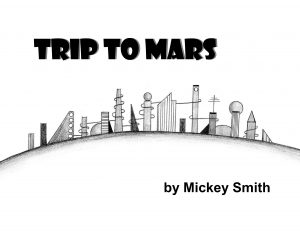 |
A picture book by Mickey Smith Published March 2017 paperback (70 pages) lulu.com Background | Excerpt (Panels 1-6 in PDF format) |
A sixth grade boy reports that World War IV has rendered the planet uninhabitable, and that Jack Commer and the crew of Typhoon I have been chosen to spearhead the evacuation of Earth’s surviving population to Mars.
Eleven-year-old Mickey Smith’s first attempt at what he called a novel, in the spring of 1964, was Trip to Mars, fifty-five penciled pages in a small yellow notebook. Starring Jack Commer and his three brothers, Trip to Mars outlined the horrors of a 2033 World War IV and the evacuation of Earth’s surviving population to Mars.
The story is a childhood prequel to–and the inspiration for–my published Jack Commer series. Many of its details were taken up in 2012’s The Martian Marauders and some, like the passenger shell catastrophes that numbed the second oldest brother Joe, came to be part of 2013’s Nonprofit Chronowar. The notebook also included a senseless Kennedy-like assassination, still fresh in my mind from the previous November.
In 2013 I expanded the twenty-page MS. (all of 2,646 words) into sixty-five pages of a few lines each, drew the illustrations in pencil on these pages, and scanned the results. The book’s first iteration in March 2014 was as a YouTube video. But I had always wanted a picture book paperback. I completed the project and made Trip to Mars available as a 9″ x 7″ paperback on lulu.com in March 2017.
Trip to Mars – The Picture Book follows the text of the 1964 notebook with only spelling corrections; for instance, I had misspelled the ship’s name “Typoon” throughout. If there are awkward phrasings and illogical plot developments, well, that’s part of the flavor. The notebook also had numerous crude drawings, some of which I used for new image ideas.
The exterior views of the Typhoon are more or less consistent, but echo the fact that I drew the ship somewhat differently every time I rendered it in scores of childhood drawings. I had fun with interior views, which are a series of theater stages and absolutely cannot be reconciled with the layout of an actual ship about the size of a space shuttle. And I never worried about depicting any of the characters consistently.
Somehow the often silly childhood words have been fully superseded by the adult illustrations; somehow the entire project blends the child and the adult–and I hadn’t really expected that.
